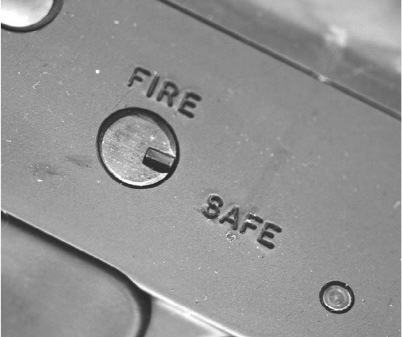
HIGH STANDARD

Lowers marked on both sides.
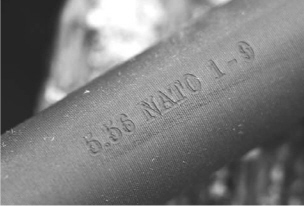
Barrels clearly marked as one turn in nine inches.
Old timers will remember High Standard as the makers of a first-class rimfire target pistol, an interesting Flite King shotgun, and the very interesting Model 10 shotgun. The Flite King and Model 10 are no more. The pistol is once again being made by the new High Standard Manufacturing Company, along with a variety of 1911 pistols. There are no two hotter market segments in the modern firearms manufacturing and sales world than the 1911 and the AR-15.
The High Standard ARs are currently four in number. An A2 rifle and carbine and a flat-top rifle and carbine. High Standard sent me an A2 rifle and a flat-top carbine. The lower forgings are A2, with the large strengthening radius at the front pivot pin and the larger boss around the buffer tube threads. The color of the upper and lower is a dark, flat gray-black. The finish is uniformly matte and the rollmarks are restrained and simple text. Were you looking for a lower to modify for a Retro rifle, the High Standard shows a great deal of promise. No need to worry about logos or rollmarks making your AR look other than “1965” in appearance.
The lowers are marked “Safe” and “Fire” on both sides. The safety lever is standard mil-spec. The buffer tube on the carbine is the non mil-spec diameter, a nominal 1.170” and the castle nut holding the rear plate on is not staked. Provided you don’t plan to change stocks, and the castle nut is torqued in tight enough to stay, both are minor quibbles. The pistol grip is an A2 on both. The lower performed correctly in all testing, the magazines went into place smoothly and without binding, dropped free when the mag button was pushed, and locked the bolt back when empty. There were no sharp edges or toolmarks on the upper or lower.
The uppers are A2 all the way. The ejection port and the forward assist are separated by the ejection “lump.” That pyramid is there for left-handed shooters. I never really gave the lump much thought, as even when I shot left-handed rifles and carbines didn’t bother me.
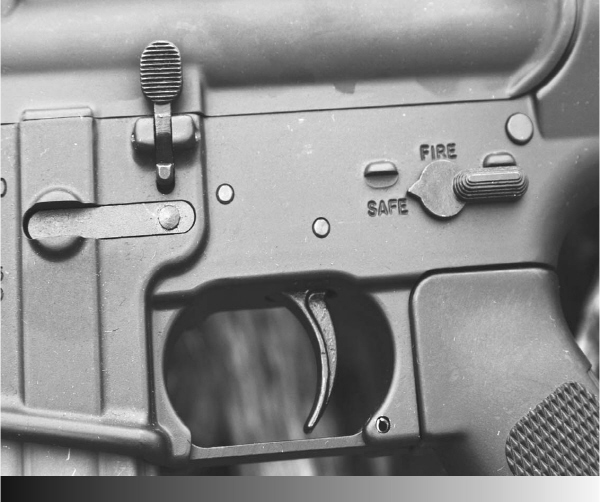
Standard controls, pistol grips, finish, everything.
My friend Jeff Chudwin, trying to test-fire an M16A1 left-handed one day (and without the lump), showed me how hard it can be. Every other empty was grazing his face, arm or ricocheting off his earmuffs. Ouch. So unless you really, really have to have that Retro AR, don’t complain about the lump. The ejection port door spring was assembled incorrectly on both rifles. Another minor point, but I’ve built over a hundred ARs myself, and inspected a couple of thousand more, and little things like that can be bothersome. Were they mine I would be compelled to strip the rifle to get the spring the right way around, but that’s just me. The flat-top carbine was not numbered in the rail slots.
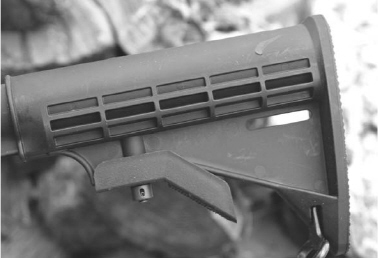
The carbine comes with a standard M4 stock on it. Not a mil-spec tube, alas.
The handguards are modern in composition but the carbine is the CAR diameter, and not the M4 diameter. If you want the double heat shields and larger size, you’ll have to swap the handguards out. For those of us who find the CAR handguards just fine, no need to change anything.
The bolts and carriers are unmarked, but properly machined/ground and phosphated. The carrier is a modified M-16, with the firing pin shrouded and the auto sear shoulder milled back. The carrier key is properly and heavily staked on both rifles. The bolts were unmarked, and the extractors had standard springs (not the new gold-color extra-strength) with blue inserts. Gold springs and black inserts are the new standard, but these two demonstrated their ability with the older extractor tension by never failing.

The buffer tube castle nut isn’t staked, but not many are. No big deal if it is tight enough to stay.
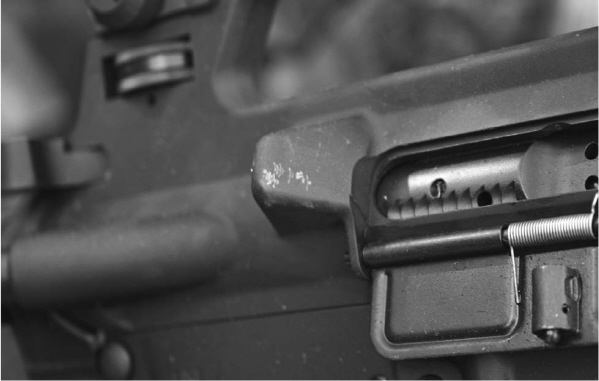
The ejector lump takes a hit and thus protects your face from the brass. I don’t notice, but lefties can have big problems otherwise.
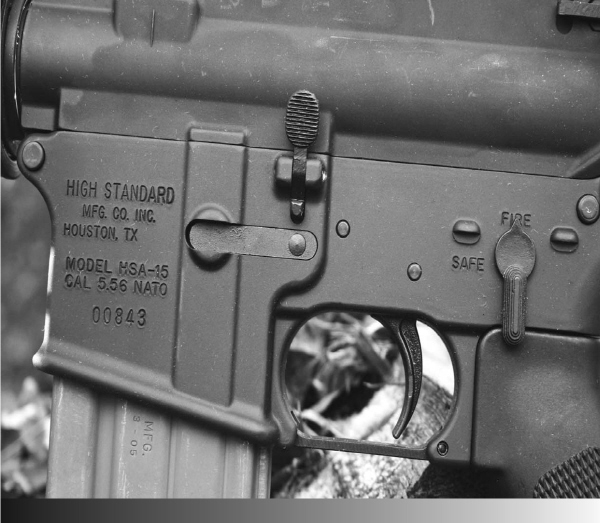
High Standard marked on the mag well, a boon to someone looking for a “Retro” rifle project lower.
The barrels are all one turn in nine inches, the modern compromise for all-around use. The markings on the barrel look very much like those on some other makers, so I suspect High Standard is getting its barrels from a big maker. If my suspicions are correct, they are getting them from a big behind-the-scenes manufacturer, and you are getting a first-class barrel on your rifle, which is how well they shot. The carbine was marked “5.56 1-9” while the rifle was simply marked “1-9.” I had no malfunctions with any ammo, from factory-new XM-193 to wimpy reloads, to steel-cased Wolf and the new Wolf Performance ammo. When fed what they liked (the carbine, Black Hills 52-grain match hollowpoint; the rifle, Wolf Performance) they were both contenders for one-MOA performances. The only thing holding them back were the triggers, but almost MOA with a military-weight trigger is not something to be ashamed of. The carbine barrel has the M4 contour, with the relief notch cut for mounting an M-203 carbine version.
The front sight housing is not “F” marked but is the correct height for a flat-top. So you won’t have any problems mounting a BUIS to the High Standard carbine. The A2 barrel is a semi-H-Bar contour, with a straight diameter of .875” underneath the handguards. Heavy enough to make it steady in offhand, but not so heavy you feel like you’re trying to shoot a railroad tie.
Both rifles had all the current niceties. The flash hiders were both the A2, with closed slots on the bottom. The carbine has an M4 stock, with stiffening ridges underneath the tube and no sling loop on the upper rear. The stock of the rifle was the A2, full length and great for target shooting. But also too long for use with body armor, but that is a concern of a small subset of the AR community. The A2 rear sight wings have the deeper markings, not the shallow ones we see on some rifles. (Probably a particular subcontractor makes those. They don’t change anything about the function of the sights.) Both rifles were correctly zeroed right out of the box, needing only a click or two to get them set up for me. Once given a NEMRT zero, I was able to drop the computer pop-ups out to 300 meters, and shoot a passing score on the qual course. (300-27X with the carbine, 300-30X with the A2. The A2 trigger was nicer, thus the three extra Xs.)
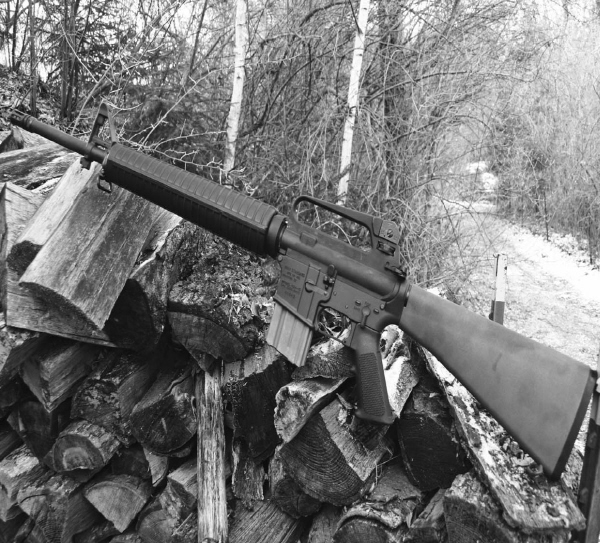
The high Standard A2 is pretty much what a Marine or soldier would be issued. No select-fire (rats) and the barrel is straight contour under the handguards.
The A2 ejected the empties behind, at a 45-degree angle. The carbine tossed them forward, again at a 45-degree angle. By AR standards they ejected consistently, leaving brass within a three-foot circle when a magazine was finished. In the course of putting a carton of Black Hills and another carton of assorted ammo (XM-193, Wolf, Radway Green, some truly wretched Portuguese and some brilliant South African), neither of the High Standard rifles gave me any problems at all.
So, what to do with them? High Standard offers four models, the four most popular versions of the AR-15. Do they offer something that one of the rest of the host of AR makers doesn’t? Not really. You can’t get other calibers, only 5.56. You can’t get barrels other than twenty or sixteen inches. No select-fire (only an option for police departments, unfortunately) and no extras. You get a rifle or carbine, in a cardboard box, with a magazine. But you get a basic rifle that is reliable, accurate, zeroed and ready to be modified howsoever you wish. For someone looking to pick up a rifle to turn into a project, or someone who wants a basic rifle and plans to never make a single change, the High Standard offerings are just the thing.
There’s a certain segment of the sales force/marketing field that stresses “value for money.” That is, not trying to squeeze each nickel until the buffalo moos, but also not over-spending for “flash” or name recognition. The High Standard rifle certainly fits the bill.
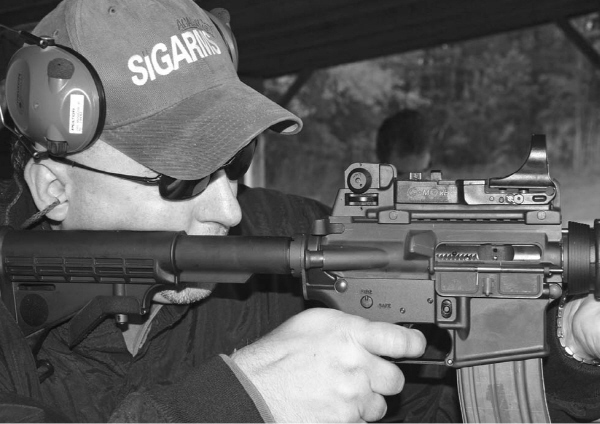
With a C-More sight on the carbine, Roy is hammering the 200-yard targets.
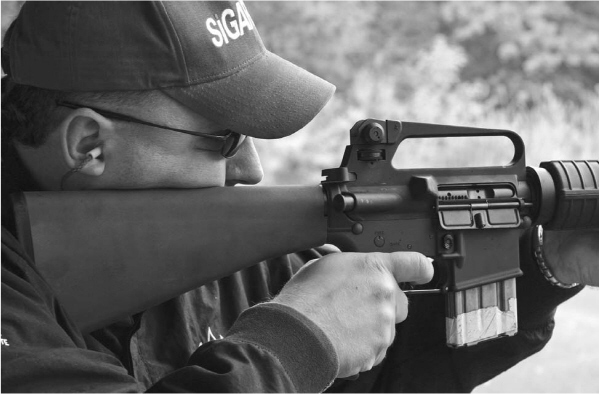
The full sized rifle was, as expected, soft in recoil and plenty accurate.